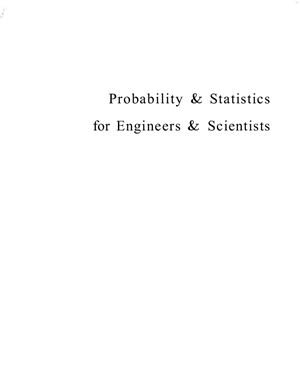8th Edition, 2007.
With its unique balance of theory and methodology, this classic text provides a rigorous introduction to basic probability theory and statistical inference, motivated by interesting, relevant applications. Offers extensively updated coverage, new problem sets, and chapter-ending material to enhance the book’s relevance to today’s engineers and scientists. Includes new problem sets demonstrating updated applications to engineering as well as biological, physical, and computer science. Emphasizes key ideas as well as the risks and hazards associated with practical application of the material. Includes new material on topics including: difference between discrete and continuous measurements; binary data; quartiles; importance of experimental design; dummy variables; rules for expectations and variances of linear functions; Poisson distribution; Weibull and lognormal distributions; central limit theorem, and data plotting. Introduces Bayesian statistics, including its applications to many fields.
For those interested in leaing more about probability and statistics.
Chapter 1 is an elementary overview of statistical inference designed for the beginner. It contains material on sampling and data analysis and contains many examples and exercises for motivation. Indeed, some very rudimentary aspects of experimental design are included along with an appreciation of graphic techniques and certain vital characteristics of data collection. Chapters 2, 3, and 4 deal with basic probability as well as discrete and continuous random variables. Chapters 5 and 6 cover specific discrete and continuous distributions with illustrations of their use and relationships among them. In addition, a substantial number of examples and exercises are given that illustrate their use. Chapter 7 is an optional chapter that treats transformation of random variables. An instructor may wish to cover this material only if he or she is teaching a more theoretical course. This chapter is clearly the most mathematical chapter in the text. Chapter 8 contains additional material on graphical methods as well as a very important introduction to the notion of a sampling distribution. Probability plotting is discussed. The material on sampling distribution is reinforced by a thorough discussion of the central limit theorem as well as the distribution of a sample variance under normal i.i.d. (independently and identically distributed) sampling. The t and F distributions are introduced along with motivation regarding their use in chapters that follow. Chapters 9 and 10 contain material on one and two sample point and interval estimation and hypothesis testing. Material on confidence intervals, prediction intervals, tolerance intervals, and maximum likelihood estimation in Chapter 9 offers the instructor considerable flexibility regarding what might be excluded in a onesemester course. Chapters 11 through 17 contain ample material for a second semester. Simple and multiple linear regression are contained in Chapters 8 and 12, respectively. Chapter 12 also contains material on logistic regression, which finds applications in many areas of engineering and the biological sciences. The material covered in multiple linear regression is quite extensive and thus provides flexibility for the instructor.
All chapters contain a large number of exercises.
With its unique balance of theory and methodology, this classic text provides a rigorous introduction to basic probability theory and statistical inference, motivated by interesting, relevant applications. Offers extensively updated coverage, new problem sets, and chapter-ending material to enhance the book’s relevance to today’s engineers and scientists. Includes new problem sets demonstrating updated applications to engineering as well as biological, physical, and computer science. Emphasizes key ideas as well as the risks and hazards associated with practical application of the material. Includes new material on topics including: difference between discrete and continuous measurements; binary data; quartiles; importance of experimental design; dummy variables; rules for expectations and variances of linear functions; Poisson distribution; Weibull and lognormal distributions; central limit theorem, and data plotting. Introduces Bayesian statistics, including its applications to many fields.
For those interested in leaing more about probability and statistics.
Chapter 1 is an elementary overview of statistical inference designed for the beginner. It contains material on sampling and data analysis and contains many examples and exercises for motivation. Indeed, some very rudimentary aspects of experimental design are included along with an appreciation of graphic techniques and certain vital characteristics of data collection. Chapters 2, 3, and 4 deal with basic probability as well as discrete and continuous random variables. Chapters 5 and 6 cover specific discrete and continuous distributions with illustrations of their use and relationships among them. In addition, a substantial number of examples and exercises are given that illustrate their use. Chapter 7 is an optional chapter that treats transformation of random variables. An instructor may wish to cover this material only if he or she is teaching a more theoretical course. This chapter is clearly the most mathematical chapter in the text. Chapter 8 contains additional material on graphical methods as well as a very important introduction to the notion of a sampling distribution. Probability plotting is discussed. The material on sampling distribution is reinforced by a thorough discussion of the central limit theorem as well as the distribution of a sample variance under normal i.i.d. (independently and identically distributed) sampling. The t and F distributions are introduced along with motivation regarding their use in chapters that follow. Chapters 9 and 10 contain material on one and two sample point and interval estimation and hypothesis testing. Material on confidence intervals, prediction intervals, tolerance intervals, and maximum likelihood estimation in Chapter 9 offers the instructor considerable flexibility regarding what might be excluded in a onesemester course. Chapters 11 through 17 contain ample material for a second semester. Simple and multiple linear regression are contained in Chapters 8 and 12, respectively. Chapter 12 also contains material on logistic regression, which finds applications in many areas of engineering and the biological sciences. The material covered in multiple linear regression is quite extensive and thus provides flexibility for the instructor.
All chapters contain a large number of exercises.

